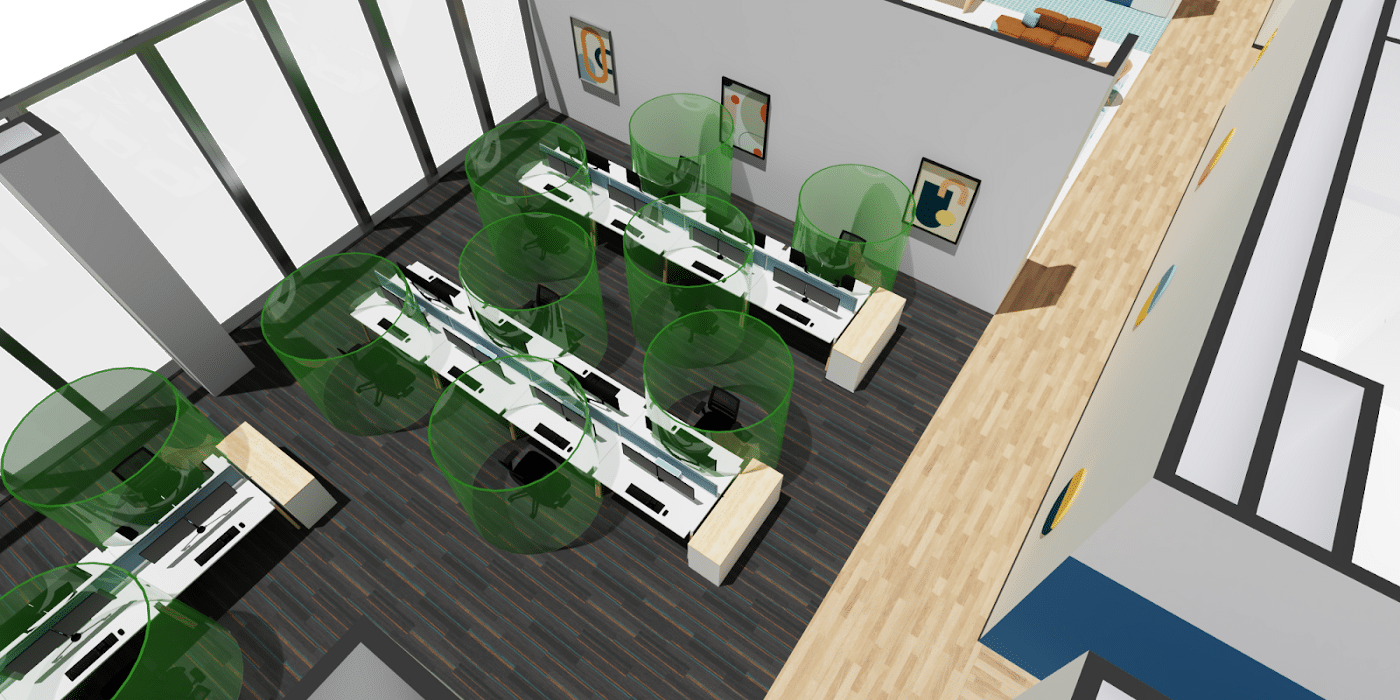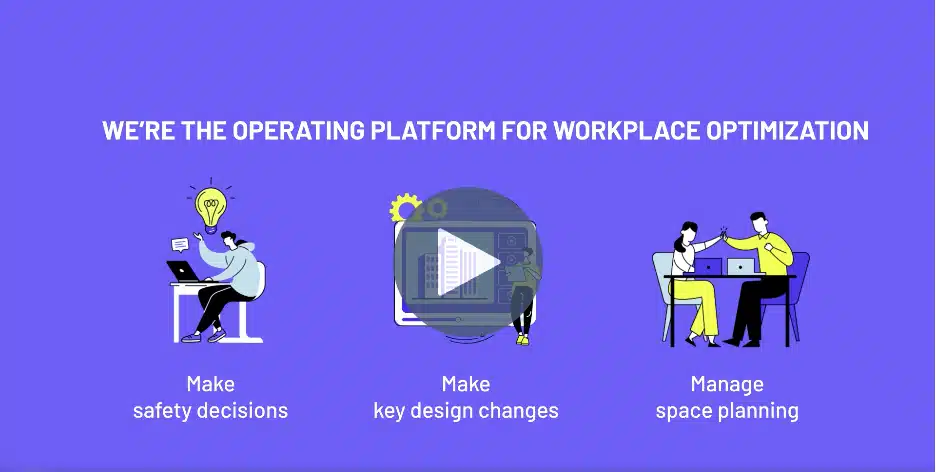Modern offices must be flexible, adaptive, and centered around how individuals, teams, and organizations actually work.
The workplace revolution is not beginning; it is already here. The old “butts in seats” strategy that offices once embraced will no longer work because it subconsciously tells employees it’s not the goals you achieve that matter, but how long you sit in front of the computer.
How people work is transforming.
Employees are asking for more flexibility, variety, and most of all, work-life balance. They want flexible workspaces that can change and morph to work habits developed from working remotely.
Modern offices must be centered around the human and must adapt to how individuals, teams, and organizations actually work. They need to respond to people’s needs and preferences if employees are going to be productive and engaged in their work. This requires a flexible mindset, a lot of data to provide insights on how people are actually using the workspace, and a thoughtful and flexible office design.
The demand for a flexible working environment is increasing
The pandemic is considered to be the reason working styles have changed in the last few years and has forced a shift towards a heavier emphasis on hybrid and remote working styles. The pandemic instantly made it a necessity, and now that businesses have embraced hybrid work, it is here to stay. Commercial real estate services form CBRE, found that 86% of its occupants said that flexible workspaces are key to their future real estate strategies.
In addition to this, many other workplace trends have also impacted workplace planning.
Other key workplace trends have also impacted workspace planning, according to the VergeSense State of the Hybrid Workspace Report:
- A new focus on employee well-being, including the creation of fitness centers in offices and the transition to natural lighting.
- Smart office technology that can monitor employee behavior and workplace usage.
- The use of data to inform leasing decisions to optimize office usage.
What is flexible office design?
Flexible office design, also known as hoteling, multi-space, or hot-desking, aims to provide workspaces that can adapt to the changing needs of its occupants. Incorporating custom-designed, modular and adjustable furniture, equipment, and technology into the floorplan facilitates flexibility.
These work environments empower and enable workers to find their focused workflow just as easily as collaborating with colleagues. A simple reconfiguration of the office’s layout, convertible by the build, will enable the company as a whole to adapt to changing, unknown needs in the future.
To understand how flexible office design came to be, it is critical to unpack the benefits and downsides of the open office design.
An open office design is more cost-effective and leads to more efficient use of space. It can also improve team camaraderie, breed creativity, remove the barrier between managers and employees, and bring in more natural light. But an open design can lead to anxiety in employees–many employees feel like they are always on “display”–and make it hard to work on projects that require focus.
A closed office design gives employees privacy and a sense of autonomy over their work. It can improve productivity by providing employees with a distraction-free environment where they can focus. However, a closed design can also lead to wasted space, is expensive, and can lead to employee isolation.
Designing flexible offices involves finding the perfect balance between quiet, dedicated spaces for deep focus and vibrant communal spaces for restorative collaboration.
How companies are reinventing workspaces
Many businesses are realizing that flexible workspaces have lasting positive effects on employees–inspiring them to collaborate more effectively and work more creatively. Here are some ways businesses are reinventing workspaces:
- Breaking down walls: Cubicles are becoming a thing of the past. Removing walls can make an office more open and allow for more collaboration.
- Putting furniture on wheels: This simple solution will give you the option to rearrange office furniture for any need. We will look at this more in the next section.
- Experimenting with desk layouts: Offices are experimenting with custom-shaped desks and new desk arrangements, as well as moveable desks that adapt to employee and project needs.
The changes in these design updates have allowed companies to:
- Attract and retain talent: By choosing amenities that reflect your company’s core values and foster a culture of collaboration, you can attract and keep top employees.
- Increase employee satisfaction: When the design of an office space responds directly to the workflow of its occupants, you’ll make better use of the space and increase employee satisfaction and performance. In just about every return-to-work survey, 80% of respondents make “wellness” their number one demand for going back.
- Support a mobile workforce: A flexible office won’t require an employee to remain at a desk to get work done, and this will foster immediate creativity by giving employees the option to choose where they work. CBRE found that 38% of large enterprises surveyed were using flex space to test alternate workspace and occupancy models.
Implementing flexible offices without huge constraints
An office that is truly flexible has multipurpose, modular furniture, equipment, and technology. To give you a sense of how versatile these pieces are, consider the following:
- L-shaped desks customized to the dominant hand of the end-user.
- Sit-to-stand desks with adjustable monitor mounts.
- Desks that double as communication boards with built-in privacy panels.
- Wire management that saves space and declutters cables.
- Adaptable training tables that can be stored out of sight as needed.
- Whiteboards that roll to make collaboration possible anywhere.
To ensure the flexibility of each of these pieces, casters, wheels, cranks, lifts, and mounts should be built-in. These pieces can be free-standing or easily disassembled. Using these features, you can easily switch between working solo, working collaboratively, and kicking back.
Since combining work and play is a fundamental goal–such as building ancillary into an office–products that combine both fit the bill perfectly. For example, a conference table that can be used for solo work, small group collaboration, and/or a game of ping-pong.
Benefits of space planning
Implementing multipurpose and modular furniture and equipment is just one of the steps toward a more flexible workspace. Once you give a workspace the ability to adapt to the changing workforce, you need a plan that keeps up with the changing needs of your dynamic workforce and fosters an engaging office experience.
This should involve using spatial intelligence technology, which can help businesses manage the design of their workplace from conception to final execution using actionable data. Space planning tools allow you to model out design changes virtually and make real-time workspace changes that enable business growth and better adapt to flexible spaces.
Space planning software can help teams:
- Streamline the whole workspace optimization process
- Explore space options to fit employee needs
- Collaborate on designs through digital tools
- Use surveys and utilization tracking to gather qualitative and quantitative data
- Digitize their real estate portfolio
- Use data to drive decisions around their entire portfolio
Simplify your workplace design and strategy with Saltmine
The nature of work is changing around us. Employees’ needs are evolving, and keeping up with them is not an easy task. Enriching the employee experience requires a human-centric office design, and employees are not all the same, so a flexible office is one key to a better workspace.
The other key is space planning. Many businesses suffer from siloed solutions when it comes to workplace design and strategy. Fragmented technologies cannot keep up with the evolving and dynamic needs of tomorrow’s workplace without a single source of truth.
You can use Saltmine to make safety adjustments, design modifications, and better inform space planning decisions, whether you’re redesigning or creating a new space. To learn how Saltmine can help you deliver a workspace your people will love, check out the video below:
Enjoying our blog? Be sure to subscribe to stay up-to-date on Saltmine's original content with the form below!



